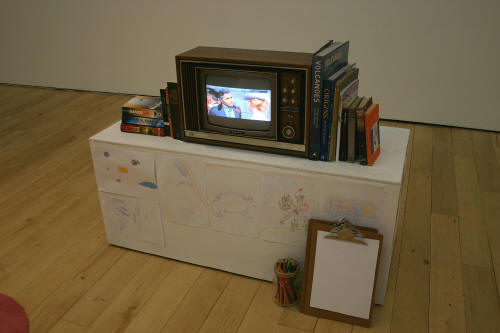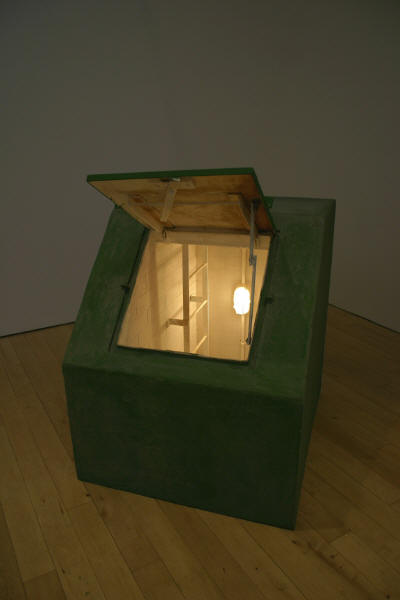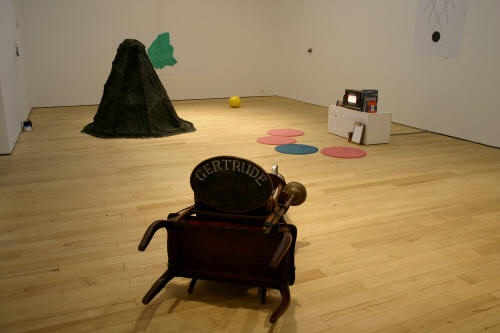|
|
| home | features | exhibitions | interviews | profiles | webprojects | gazetteer | links | archive | forum |
|
Transition: Curator's Edition Week 2: 30th January to 3rd February, 2008: Sovay Berriman and Bruce Davies
Journey to the Centre of the Earth Curated by Sovay Berriman The soundtrack of the 1959 film 'Journey to the center of the Earth', featuring the mellifluous tones of James Mason, drifts around the upper gallery. The film's lush orchestration, and vivid technicolour is as evocative of the mid-twentieth century as the wood-veneered TV it is playing on. Watching the protagonists of the film being chased by giant lizards the viewer is transported both to the centre of the earth, and to a time before Toy Story and CGI, when fantasy landscapes were rendered painstakingly using carefully painted mattes and animation.
The original story, written in 1864 by Jules Verne, was one the first science fiction stories, and Steven Paige's sculpture protruding for several feet across the floor, refers further back in history to this original source. 'Gertrude' (below) is a contraption that looks a bit like a wooden drilling device, or time machine. Its function, however, remains ambiguous, and though it looks spontaneous, like a child's plaything, its components are all pieces of antique Victorian and Edwardian furniture, which suggests a more deliberate process of construction.
'Bunker' by Patrick Lowry (below) is a similarly polyvalent sculpture comprising a green box, with an open hatch and a ladder inside. Like Paige's work it implies a human presence, and in this case a glowing yellow bulkhead light seems to beckon the viewer to climb inside. Well-made and aged in a perfectly plausible way, a mirror in the floor suggests that the internal passage is deeper than it really is and - like the mirrors in Cocteau's films - it marks a transition between the real world and the imaginary. Whilst the work relates to the film's theme, the title hints at science fiction become reality: at air-raid shelters and nuclear bombs.
In contrast to the other works, Oliver Sutherland's 'The Volcano Will Blow' has been constructed in the space over the five days of the exhibition, and, in its penultimate form, looks imposingly black, bulky and inscrutable. As the title suggests it is destined to 'erupt' at some point towards the end of the show. Kitty Wingate's work nearby is similarly abstract: 'Untitled' is a football-sized highly glossy yellow sphere: similar to Katie Holten's globes but somehow evocative of the sun. 'Rock' is a flat map-like green drawing comprising hundreds of little triangles, that together look like facets of a jewel. This latter work links directly to Sovay Berriman's irregular glittering form placed high on the wall overlooking the rest of the space. Called 'Gem Mine' it is also green and plays alluringly with scale, by being suggestive both of a miniature landscape and or massive gemstone.
Unlike the other works which were commissioned for the show and made in response to the film, the two smaller pieces by Matthew Houlding and Karen Di Franco were already in existence. Both pull in different directions to the other works, and situated on the wall as they are, seem to serve as reminders of the real world. Di Franco's doodled postcards of mid-century American sky-scrapers have the words 'Stay' and 'Please Dont Go' written into the window-frames. Houlding's work is a miniature diorama comprising toy car, with fake vegetation and sunset.
Bearing over all the work was a large poster bearing an enigmatic pictogram or sigil that served as a symbol for the show as a whole. Featuring on all the promotional material, and on postcards made for the exhibition, its purpose or meaning was left unexplained.
Original trailer for Journey to the Center of the Earth
Let's Play Records Curated by Bruce Davies
In the years that it has been running, 'Transition' at the Newlyn has been characterised by being playful and transitory: both qualities that were taken to new heights by Bruce Davies' show 'Lets Play Records'. Inspired by the increasingly archaic but fondly-remembered technology of the vinyl record, Let's play Records was a multi-part interactive installation that was improvised around a strong central theme: a structure, in fact, not unlike the Thelonius Monk tune that was being belted out when I arrived to look round.
The central idea was that members of the public could come into the space and play records that had been collected together by the artist in the few weeks leading up to the show. This seems like a simple idea but it worked well, which is an achievement considering so many artworks inspired by relational aesthetics and similar notions just don't. (Instead, by virtue of being too obscure they tend to make visiting adults feel awkward and embarrassed). By contrast the relaxed atmosphere created by Davies' was like convivial record shops of old: where customers could browse unselfconsciously and in their own time.
Other elements were then added to the mix: this included posters of Marshall Amps, drawings of rock-stars, rotor-reliefs like those made by Duchamp, collages of faces from record covers, and most evocatively, a film made by Davies of the EMI factory in Middlesex where vinyl records are still made and where in the past records like 'Hey Jude' and 'Bohemian Rhapsody' would have been pressed. There were a number of programmed events too. On the Saturday night, for example, nearly 100 people crammed into the small space for 'Death Disco' with 'Cobra Club' on the decks.
The show as a whole therefore became a kind of playful deconstruction of the record as product: appropriately enough taking the form of a shrine not unlike a messy teenagers bedroom, or student 'crash-pad'.
Words and photos: Rupert White
|
|
|



